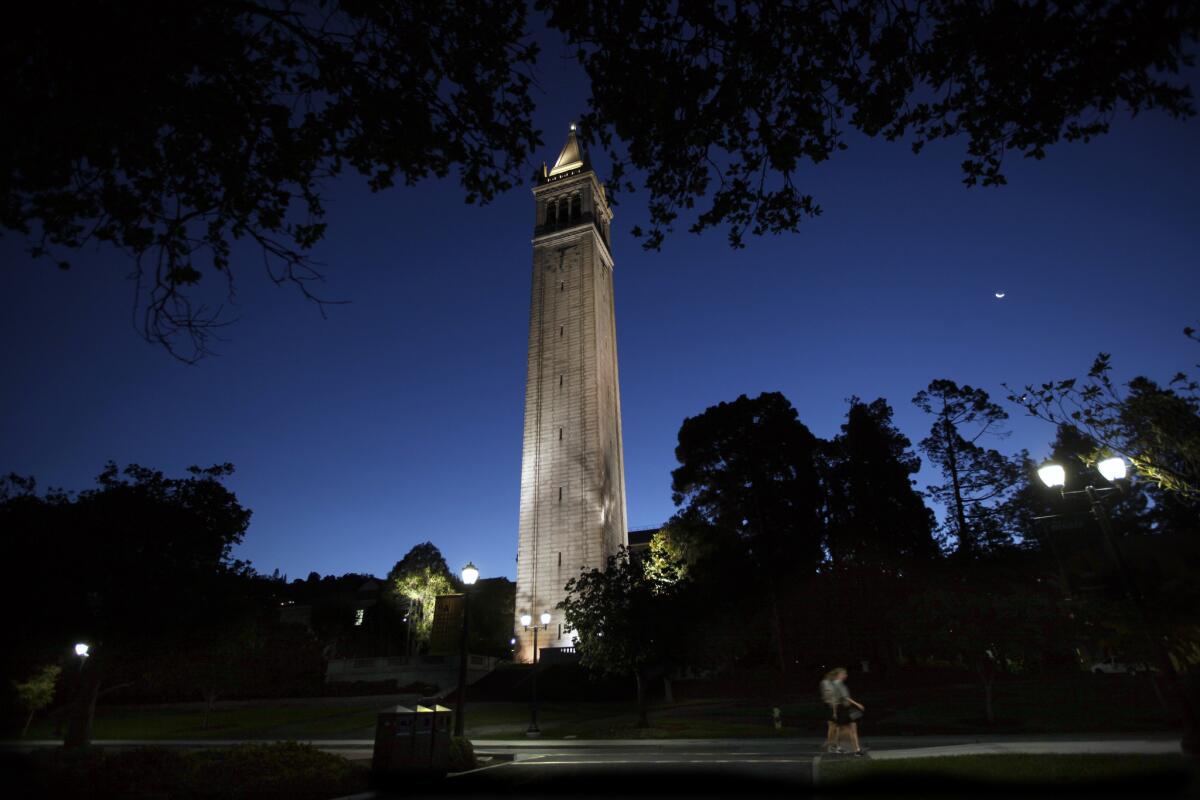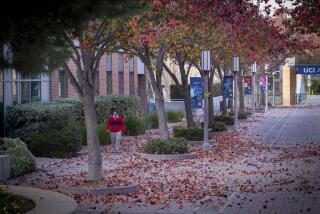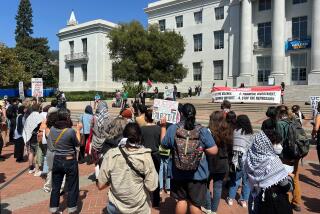As UC Berkeley tries to close its deficit, administrators feel the ire of traditional faculty allies

The landmark Campanile on the UC Berkeley campus.
As top UC Berkeley officials lead an ambitious effort to reshape the nation’s premier public research institution, they are facing increasingly fierce reactions from their usual allies — the faculty.
Chancellor Nicholas Dirks announced in February that the flagship University of California campus would need to reinvent itself to cope with a $150-million budget deficit and the likelihood that state financial support will not return to the more generous levels of the past.
But many professors say they have been largely left out of the early planning efforts, counter to Berkeley’s long tradition of joint decision-making between administrators and faculty.
At a testy Academic Senate meeting with Dirks last week, professors complained the process has been shrouded in secrecy. They say few details about the school’s deficit, budget reduction targets, plans to redesign academic programs and other key issues have been disclosed.
The Office of Strategic Initiatives, formed in February to lead the campus transformation process, was disparaged for failing to seek wide input from the 2,200 professors, lecturers and other instructors on campus.
John Taylor, professor of plant and microbial biology, complained to Dirks that administrators denied his request to see the financial data supporting the budget deficit projections, according to a transcript of the April 12 meeting.
“To be true partners in solving the budget deficit problem, we need to be shown all of the data,” said Paul Fine, an associate professor of integrative biology who co-organized the meeting.
“It’s unbelievable to me that a Berkeley professor can head the Federal Reserve,” he said, referring to Fed Chair Janet Yellen, “and yet somehow the campus budget is a more opaque and difficult program than the entire U.S. economy.”
Several critics complained about the top-down way academic departments were selected as candidates for potential streamlining. That could involve coordinating or sharing resources, or possibly even mergers.
In a recent memo, Dirks mentioned four colleges — Letters and Science, Engineering, Chemistry and Natural Resources — as well as the Division of Biological Sciences and smaller professional schools, such as Public Health and Social Welfare.
Deans were asked not to discuss their initial ideas with faculty, said Berkeley spokesman Dan Mogulof, but only after some of the deans requested confidentiality so they could “speak candidly about moves that might be unpopular.”
Indeed, recent proposals to merge the College of Chemistry into other academic units and suspend spring admissions for the School of Public Health sparked protests from students, faculty and alumni — in part because they were announced without first seeking advice from the Berkeley community. The outcries prompted campus leaders to reverse course.
Dirks, in a statement to The Times, said his intentions have been misconstrued and that he has provided regular updates about the budget process in hopes of boosting faculty participation. He said some faculty were operating on “incomplete information” about the planning process and his commitment to collaboration.
But he said he would expand and accelerate efforts to “make clear that the faculty are not just partners, but architects with us of any institutional decisions we make. ... This must indeed be the case if we are to succeed in our quest to secure Berkeley’s excellence for generations to come.”
At the faculty meeting, Dirks acknowledged that any changes to Berkeley’s academic programs would probably save only a few million dollars. But he said the main reason to redesign them would be to settle on an academic vision in line with new budget realities.
The chancellor said the campus has taken a “huge step forward” in reducing the deficit, which could have grown to nearly $200 million next year without action.
Budget cuts of 1% to 4% across all campus units and other reductions will help save $20 million, and restructuring loans for construction projects will save another $16.5 million, he said. In addition, the university can raise $50 million through actions like increasing the administrative fee on philanthropic gifts. Altogether, these could bring the deficit down to as little as $105 million by June 2017, or about 4% of Berkeley’s $2.5-billion operating budget this year.
Dirks also told the campus community last week that he would eliminate roughly 500 campus jobs over the next two years — many through attrition — for a savings of about $50 million. The aim is to be back in the black within five years, he said.
But many faculty and staff have urged that the first cuts be aimed at administrators, whose ranks have grown much faster than those of faculty or students.
Between 2005 and 2015, the number of full-time administrators at Berkeley grew 56%, from 821 to 1,281, while full-time tenure-track faculty increased 1.9%, from 1,261 to 1,285, according to UC statistics.
More administrators have been hired for fundraising, technology operations, financial planning, student services, building maintenance and campus safety, Mogulof said. Even so, the ratio of staff to academic employees is the lowest in the 10-campus UC system, he said.
Berkeley has reduced the number of top executives from 69 in 2002 to 67 in 2015 but increased their total pay from $10 million to $15 million during that same period. Inflation and the need to match rising salaries in the Bay Area labor market drove the increase, Mogulof said.
He added, however, that executive compensation as a percentage of Berkeley’s operating budget declined from 0.75% in fiscal year 2002 to 0.57% in 2015.
Carolyn Merchant, a professor of environmental history, philosophy and ethics, kicked off the faculty comments at last week’s meeting with a call for a “revolution in cost reduction” led by dramatic cuts in the number and pay of administrators. She also urged more effective fundraising and less paperwork.
“We call on the administration to lead the revolution, not by consolidating Berkeley’s excellent existing academic units, but by looking deeply into its own operations and its own expenses,” Merchant said.
Celeste Langan, a member of the English department and co-chair of the Berkeley Faculty Assn., said a majority of professors shared that sentiment. Shrinking Berkeley’s vaunted academic programs will jeopardize what makes the university a top-ranked global brand: its comprehensive excellence, they said.
Berkeley officials countered that the campus has evolved over time — closing the School of Criminology in the 1980s, for instance — while retaining its reputation for excellence.
Genaro Padilla, chair of the English department, asked Dirks for the gender, race and ethnicity of those whose positions would be eliminated, expressing concern that the rank-and-file typically suffer the most from budget cuts.
Todd Stenhouse, a spokesman for the American Federation of State, County and Municipal Employees, Local 3299, said his members already were stretched thin by past cuts and could not take on more work. He said increased workloads were one reason the on-the-job injury rate has increased by 17% since 2009 among his union’s gardeners, custodians, food-service workers and other members.
Custodians in particular have suffered from back, shoulder, neck and ankle injuries, he said: “Front-line staff is being asked to do more with less.”
Many faculty members suggested that more fundraising is the key to resolving Berkeley’s budget woes. However, they fret that donors could then shape the university’s research and academic offerings to suit their private interests.
Michael Burawoy, a sociology professor and co-chair of the Berkeley Faculty Assn., said the best long-term solution would be more state funding. To get it, he said, UC needs to make a stronger case for its critical importance to California.
In recent months, however, UC’s reputation has been clouded by a string of controversies over sexual harassment cases and a state audit alleging that the system harmed California students by admitting too many applicants from outside the state.
“The university has to reconceive itself to be accountable to the California public,” Burawoy said.
Twitter: @TeresaWatanabe
ALSO
Will Santa Monica’s Expo Line get you out of your car?
California water agencies are expected to urge regulators to ease drought restrictions
California lawmakers advance gun control measures in response to San Bernardino massacre
More to Read
Sign up for Essential California
The most important California stories and recommendations in your inbox every morning.
You may occasionally receive promotional content from the Los Angeles Times.











